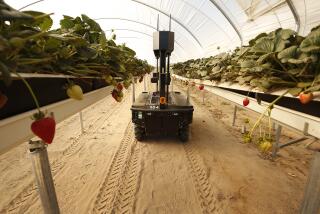Agriculture Education Withering
At Canoga Park High School, things look much like a zoo.
There’s a pig so fat that it can’t be weighed on the scale, a chicken that plucks away at another fighting for a prime place to lay an egg and goats that get their heads stuck under a fence reaching for greener grass.
But this is controlled chaos. Nurtured nature. Also known as agricultural education, a field of study that has withered away in the Los Angeles Unified School District. Today, ag ed, as it’s called, can be found at only a few district schools.
The demise counters the state and national trend that shows a growing interest at high schools and community colleges in agriculture, which, experts said, is a result of new technology in the industry.
In Los Angeles Unified, duck coops, cabbage patches and rose gardens, which once covered acres at campuses, now occupy slivers of open space in the shadow of classroom trailers, football fields and construction sites. The district’s few remaining agricultural properties are held dear by students and teachers, who worry that the programs are slowly becoming extinct.
“Because of a shortage of space, we cannot be running farms in the middle of L.A.,” said district Supt. Roy Romer, who grew up during the Great Depression on a farm in eastern Colorado and later received degrees in agricultural economics and animal husbandry.
Though agreeing that ag ed is a valued subject that instilled a strong work ethic in him, Romer said there is little the district can do to halt the decline of the programs.
Teachers fear that if the programs die off, more children will grow up thinking food comes from supermarkets, not fields and farms. Students will lose important lessons in how to live healthy lives and cultivate food in environmentally responsible ways. And perhaps, most crucially, students will be less prepared to take jobs in the expanding agribusiness industry, which relies more and more on technology and research, the teachers said.
“Every other subject exists because of agriculture,” said Carrie Robertson, an agriculture teacher at Canoga Park. “People need to understand that the strength of any society is its ability to feed itself.”
Technology Helps Boost Growth
Across the country, interest in ag ed is on the rise. Future Farmers of America, an organization that helps develop agricultural education curriculum, has reported an 18-year high in membership. The number of participants not only stayed strong in historically agricultural areas elsewhere in California and Texas, but also in such cities as Chicago and San Francisco.
“Things have been steady, because agriculture is a very broad industry,” said Bill Stagg, a Future Farmers spokesman. “The old perception is that this is just farming. But any career is accessible through agriculture, from forestry to marketing to horticulture and research.”
David Wehner, dean of the agriculture department at Cal Poly San Luis Obispo, said the agricultural industry has grown in recent years with the advent of technology such as bioengineering.
“There are so many tremendous opportunities,” he said.
In California, enrollment in Future Farmers has jumped from 36,400 a decade ago to 55,000 today, which also reflects how many students are enrolled in ag ed programs in the state, said Charles Parker, the organization’s state representative.
Even the number of ag ed teachers in high schools and community colleges statewide has increased. Membership in the California Agricultural Teachers Assn., which represents 92% of the state’s active ag ed faculty, has grown from 500 a decade ago to 740 today, said Jim Aschwanden, the association’s executive director.
There are ag ed programs at 326 high schools, about a third of the total campuses, in the state. The strongest areas for the subject are Central California and the North Coast, although there are some active spots in Southern California, Aschwanden said.
In Los Angeles County, ag ed is scarce in urban areas, although programs abound in the northern region at such places as the Antelope Valley Union High School District, where five of the nine campuses have programs.
In Ventura County, agriculture programs continue to hold steady from Santa Paula to Simi Valley. Several high schools have agriculture science courses or academies, and more than three-fourths of the county’s schools have gardens used to teach youngsters where their food comes from.
Orange County is similar, with thriving secondary school programs like those in the Fullerton Joint Union High School District, where five of the six campuses have working farms that raise livestock.
Agricultural education has been in a steady decline in Los Angeles Unified since the 1980s, when the district began to phase out vocational studies to give students the time to meet the increased credit requirements for graduation.
Up to that point, about 80 schools in the district offered agricultural education, with an enrollment of about 10,000 students.
Today only 19 L.A. Unified campuses--11 high schools and eight middle schools--offer ag ed, with an enrollment of 2,000, the district said.
In the past, when new schools were built, the district would be pressured by local industry to leave space open for ag ed programs, said Art Hanson, who retired in 1992 but had either taught or supervised agricultural education in the district for 34 years.
With the decline of farming in the San Fernando Valley and other parts of the school district, that pressure disappeared, he said.
‘I Think We’re Dinosaurs’
Of the 85 schools the district plans to build in the next six years, none will offer agricultural education, said Linda Salomon, an L.A. Unified spokeswoman.
“The future is very dim,” said Arnold Vosburgh, an ag ed teacher at Narbonne High School in Harbor City. “I think we’re dinosaurs.”
Today, remaining ag ed teachers in the Los Angeles school district are mainly veterans. Hanson said programs were shut down when retiring agriculture teachers were not replaced. Aside from being too costly, ag ed became unfashionable among students, occupied too much space and took away from promoting higher math and literacy scores, many educators said.
Only a few campuses--including Canoga Park, Gardena and North Hollywood high schools--house animals and grow plants. The 19 Los Angeles Unified programs receive district funding as well as federal support, and sometimes raise extra money by selling produce and meat from the farms.
“If you look at the numbers, [the district] is not supporting ag ed,” Robertson said. “It’s not that they don’t care; it’s that they can’t take care of basic academic needs, let alone something extra like us.”
The students who take agriculture classes display genuine enthusiasm for the subject, often spending time on the campus farms after school.
Joe Saurer, 16, of Canoga Park finds himself on the school’s 11/2-acre farm almost every afternoon after class, although he is not enrolled in any ag ed class this semester. The junior said he initially wanted to become a veterinarian, but enjoyed Canoga Park’s program so much that he is thinking of becoming an ag ed teacher.
Standing amid a dozen classmates recently, Saurer helped coach a team preparing for an animal breeds identification competition held at the school.
“That’s a Balinese, not a Bombay,” he said to a student who incorrectly named a picture of a cat.
The students chuckled and quizzed each other with all the excitement one would expect to find in the most popular after-school club. Except instead of cheerleading or playing musical instruments, these kids raise swine and plant heirloom tomatoes.
One way teachers hope to ensure a future for ag ed in the district is to offer classes that carry more credits toward graduation.
*
Times staff writer Jenifer Ragland contributed to this report.







